check engine CHEVROLET KODIAK 2004 Repair Manual
[x] Cancel search | Manufacturer: CHEVROLET, Model Year: 2004, Model line: KODIAK, Model: CHEVROLET KODIAK 2004Pages: 366, PDF Size: 6.87 MB
Page 328 of 366
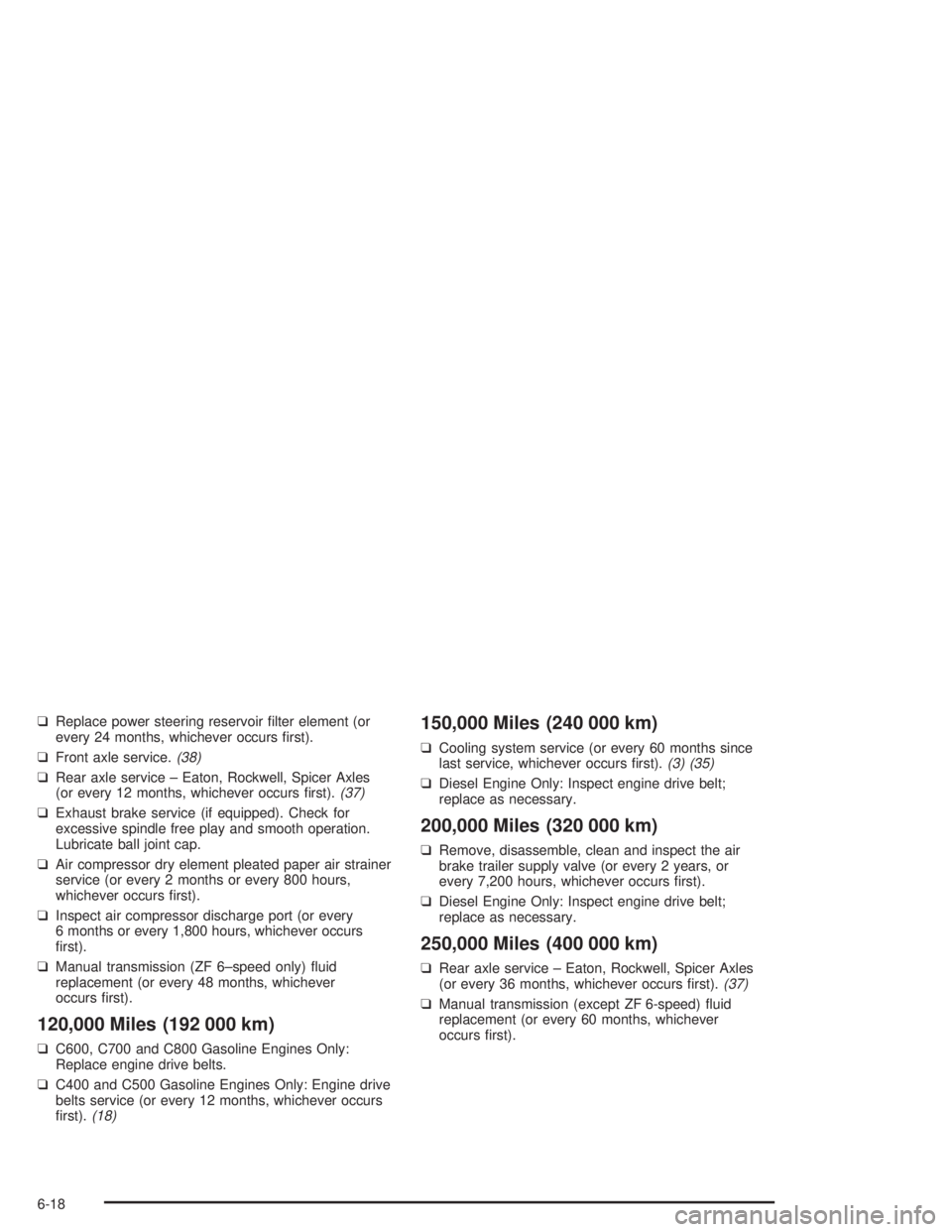
❑Replace power steering reservoir filter element (or
every 24 months, whichever occurs first).
❑Front axle service.(38)
❑Rear axle service – Eaton, Rockwell, Spicer Axles
(or every 12 months, whichever occurs first).(37)
❑Exhaust brake service (if equipped). Check for
excessive spindle free play and smooth operation.
Lubricate ball joint cap.
❑Air compressor dry element pleated paper air strainer
service (or every 2 months or every 800 hours,
whichever occurs first).
❑Inspect air compressor discharge port (or every
6 months or every 1,800 hours, whichever occurs
first).
❑Manual transmission (ZF 6–speed only) fluid
replacement (or every 48 months, whichever
occurs first).
120,000 Miles (192 000 km)
❑C600, C700 and C800 Gasoline Engines Only:
Replace engine drive belts.
❑C400 and C500 Gasoline Engines Only: Engine drive
belts service (or every 12 months, whichever occurs
first).(18)
150,000 Miles (240 000 km)
❑Cooling system service (or every 60 months since
last service, whichever occurs first).(3) (35)
❑Diesel Engine Only: Inspect engine drive belt;
replace as necessary.
200,000 Miles (320 000 km)
❑Remove, disassemble, clean and inspect the air
brake trailer supply valve (or every 2 years, or
every 7,200 hours, whichever occurs first).
❑Diesel Engine Only: Inspect engine drive belt;
replace as necessary.
250,000 Miles (400 000 km)
❑Rear axle service – Eaton, Rockwell, Spicer Axles
(or every 36 months, whichever occurs first).(37)
❑Manual transmission (except ZF 6-speed) fluid
replacement (or every 60 months, whichever
occurs first).
6-18
Page 329 of 366

300,000 Miles (480 000 km)
❑Remove, disassemble, clean and inspect the air
brake air dryer (or every 3 years, or 10,800 hours,
whichever occurs first). Replace desiccant on
Bendix-Westinghouse units.
Footnotes
† = The U.S. Environmental Protection Agency or the
California Air Resources Board has determined that the
failure to perform this maintenance item will not nullify
the emission warranty or limit recall liability prior to
the completion of the vehicle’s useful life. We, however,
urge that all recommended maintenance services be
performed at the indicated intervals and the
maintenance be recorded.
(1)= If your vehicle has an Allison automatic
transmission, your GM owner’s manual is supplemented
by an Allison Transmission
®Operator’s Manual.
Always refer to these manuals for related maintenance
services.
(2)= Refer to the Caterpillar
®Diesel Engine Operation
and Maintenance Manual for oil recommendations
and change intervals.
(3)= An Emission Control Service.
(4)= A Noise Emission Control Device.
(5)= Applies only to vehicles sold in the United States.(6)= Check fluid level in brake master cylinder, power
steering pump, axle, transmission and hydraulic
spring parking brake pump (if equipped). A low fluid
level in the brake master cylinder can indicate
worn brake linings and should be checked accordingly.
(7)= Inspect brake lines and hoses for proper
hook-up, binding, leaks, cracks, chafing, etc. Inspect
disc brake pads for wear and rotors for surface
condition. Inspect caliper assemblies. Check brake
pedal for excessive free play or travel (or every
6 months, whichever occurs first) and have serviced if
needed. Check brakes more often if driving habits
and conditions result in frequent braking.
(8)= Inspect parking brake drum and linings for wear or
cracks and check linkage and adjustment.
(9)= This vehicle has the GM Oil Life System. This
system will show you when to change the engine oil and
filter – usually between 3,000 miles (5 000 km) and
7,500 miles (12 000 km) since your last oil change.
Under severe conditions, the indicator may come on
before 3,000 miles (5 000 km). Never drive your vehicle
more than 7,500 miles (12 000 km) or 12 months
without an oil and filter change.
Remember to reset the Oil Life System whenever the oil
is changed. For more information, seeChange Engine
Oil Light on page 3-39.
6-19
Page 331 of 366

(14)= Check front and rear suspension. Look for
damaged, loose or missing parts or parts showing signs
of wear or lack of lubrication. Replace parts as
needed.
(15)= Adjust tire pressures as indicated on the GVW
Rating label for optimum tire life. SeeTires on page 5-68
for further details. Check tires for excessive or
abnormal wear or damage. Also check for damaged
wheels. Replace wheels and/or tires as needed.
(16)= Check spring-to-axle U-bolts and shackle bolts
for proper torque. See the service manual for torque
sequence and specifications. When parts are replaced,
the torque must be checked and adjusted more often
during the first 6,000 miles (10 000 km). Check torque at
500 miles (800 km) and 2,000 miles (3 000 km) after
first use of parts.
(17)= Check complete exhaust system and cab areas
near the exhaust system for broken, damaged,
missing or out-of-position parts. Also inspect for open
seams, holes, loose connections or other conditions
which could let exhaust fumes seep into the driver
compartment. Needed repairs should be made at once.
To help maintain system integrity, replace exhaust
pipes whenever a new muffler is put on.(18)= Check all gasoline engine drive belts for cracks,
fraying and wear. Replace as needed.
(20)= With the engine off and below normal operating
temperature, check to see that the thermostatically
controlled engine cooling fan can be rotated by hand on
viscous-operated drives. Replace as needed.
(21)= Check shields and underhood insulation for
damage or looseness. Adjust or replace as needed.
23)= Wheel bearing service:
•Grease type – Clean, inspect and lubricate with the
proper wheel bearing grease at designated intervals
or when hubs are removed. SeePart C:
Recommended Fluids and Lubricants on page 6-29.
•Oil-filled type – Some wheel bearings are lubricated
by rear axle lubricant. When you have oil-filled
hubs, use lubricant identical to that used in your rear
axle. Lubricant change intervals are the same for
front and rear axles. However, you must maintain oil
level at the OIL LEVEL mark between change
intervals. SeePart C: Recommended Fluids and
Lubricants on page 6-29.
6-21
Page 332 of 366
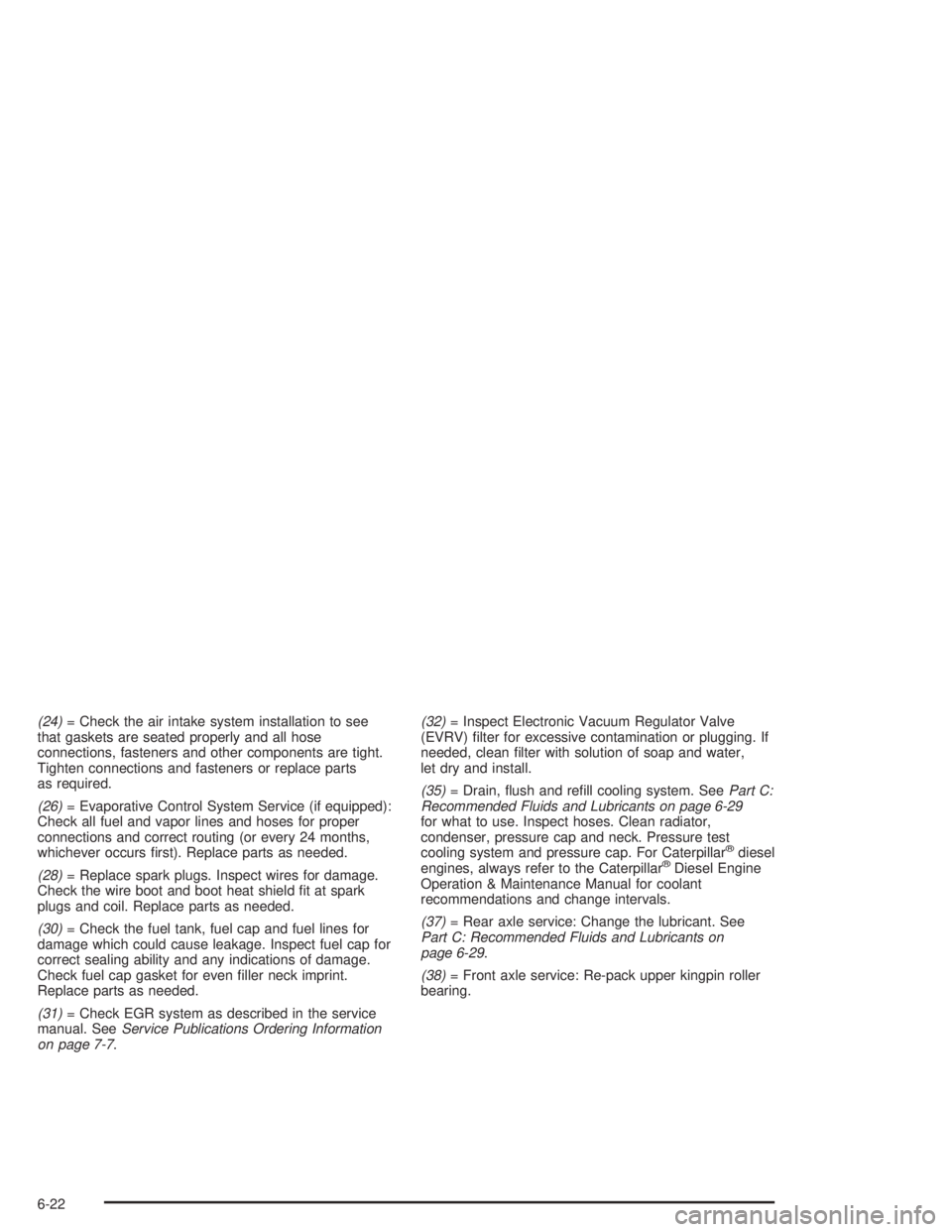
(24)= Check the air intake system installation to see
that gaskets are seated properly and all hose
connections, fasteners and other components are tight.
Tighten connections and fasteners or replace parts
as required.
(26)= Evaporative Control System Service (if equipped):
Check all fuel and vapor lines and hoses for proper
connections and correct routing (or every 24 months,
whichever occurs first). Replace parts as needed.
(28)= Replace spark plugs. Inspect wires for damage.
Check the wire boot and boot heat shield fit at spark
plugs and coil. Replace parts as needed.
(30)= Check the fuel tank, fuel cap and fuel lines for
damage which could cause leakage. Inspect fuel cap for
correct sealing ability and any indications of damage.
Check fuel cap gasket for even filler neck imprint.
Replace parts as needed.
(31)= Check EGR system as described in the service
manual. SeeService Publications Ordering Information
on page 7-7.(32)= Inspect Electronic Vacuum Regulator Valve
(EVRV) filter for excessive contamination or plugging. If
needed, clean filter with solution of soap and water,
let dry and install.
(35)= Drain, flush and refill cooling system. SeePart C:
Recommended Fluids and Lubricants on page 6-29
for what to use. Inspect hoses. Clean radiator,
condenser, pressure cap and neck. Pressure test
cooling system and pressure cap. For Caterpillar
®diesel
engines, always refer to the Caterpillar®Diesel Engine
Operation & Maintenance Manual for coolant
recommendations and change intervals.
(37)= Rear axle service: Change the lubricant. See
Part C: Recommended Fluids and Lubricants on
page 6-29.
(38)= Front axle service: Re-pack upper kingpin roller
bearing.
6-22
Page 333 of 366
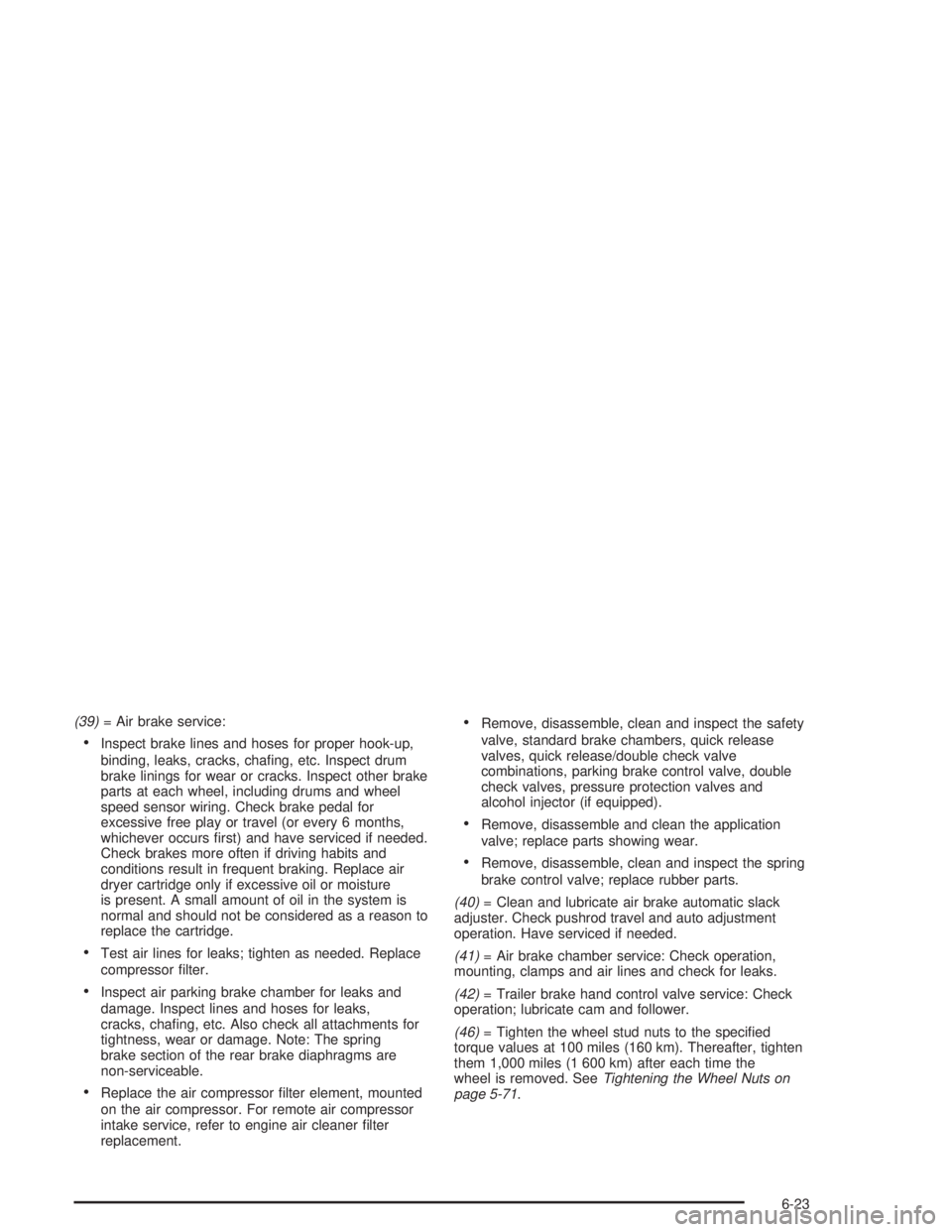
(39)= Air brake service:
•Inspect brake lines and hoses for proper hook-up,
binding, leaks, cracks, chafing, etc. Inspect drum
brake linings for wear or cracks. Inspect other brake
parts at each wheel, including drums and wheel
speed sensor wiring. Check brake pedal for
excessive free play or travel (or every 6 months,
whichever occurs first) and have serviced if needed.
Check brakes more often if driving habits and
conditions result in frequent braking. Replace air
dryer cartridge only if excessive oil or moisture
is present. A small amount of oil in the system is
normal and should not be considered as a reason to
replace the cartridge.
•Test air lines for leaks; tighten as needed. Replace
compressor filter.
•Inspect air parking brake chamber for leaks and
damage. Inspect lines and hoses for leaks,
cracks, chafing, etc. Also check all attachments for
tightness, wear or damage. Note: The spring
brake section of the rear brake diaphragms are
non-serviceable.
•Replace the air compressor filter element, mounted
on the air compressor. For remote air compressor
intake service, refer to engine air cleaner filter
replacement.
•Remove, disassemble, clean and inspect the safety
valve, standard brake chambers, quick release
valves, quick release/double check valve
combinations, parking brake control valve, double
check valves, pressure protection valves and
alcohol injector (if equipped).
•Remove, disassemble and clean the application
valve; replace parts showing wear.
•Remove, disassemble, clean and inspect the spring
brake control valve; replace rubber parts.
(40)= Clean and lubricate air brake automatic slack
adjuster. Check pushrod travel and auto adjustment
operation. Have serviced if needed.
(41)= Air brake chamber service: Check operation,
mounting, clamps and air lines and check for leaks.
(42)= Trailer brake hand control valve service: Check
operation; lubricate cam and follower.
(46)= Tighten the wheel stud nuts to the specified
torque values at 100 miles (160 km). Thereafter, tighten
them 1,000 miles (1 600 km) after each time the
wheel is removed. SeeTightening the Wheel Nuts on
page 5-71.
6-23
Page 334 of 366
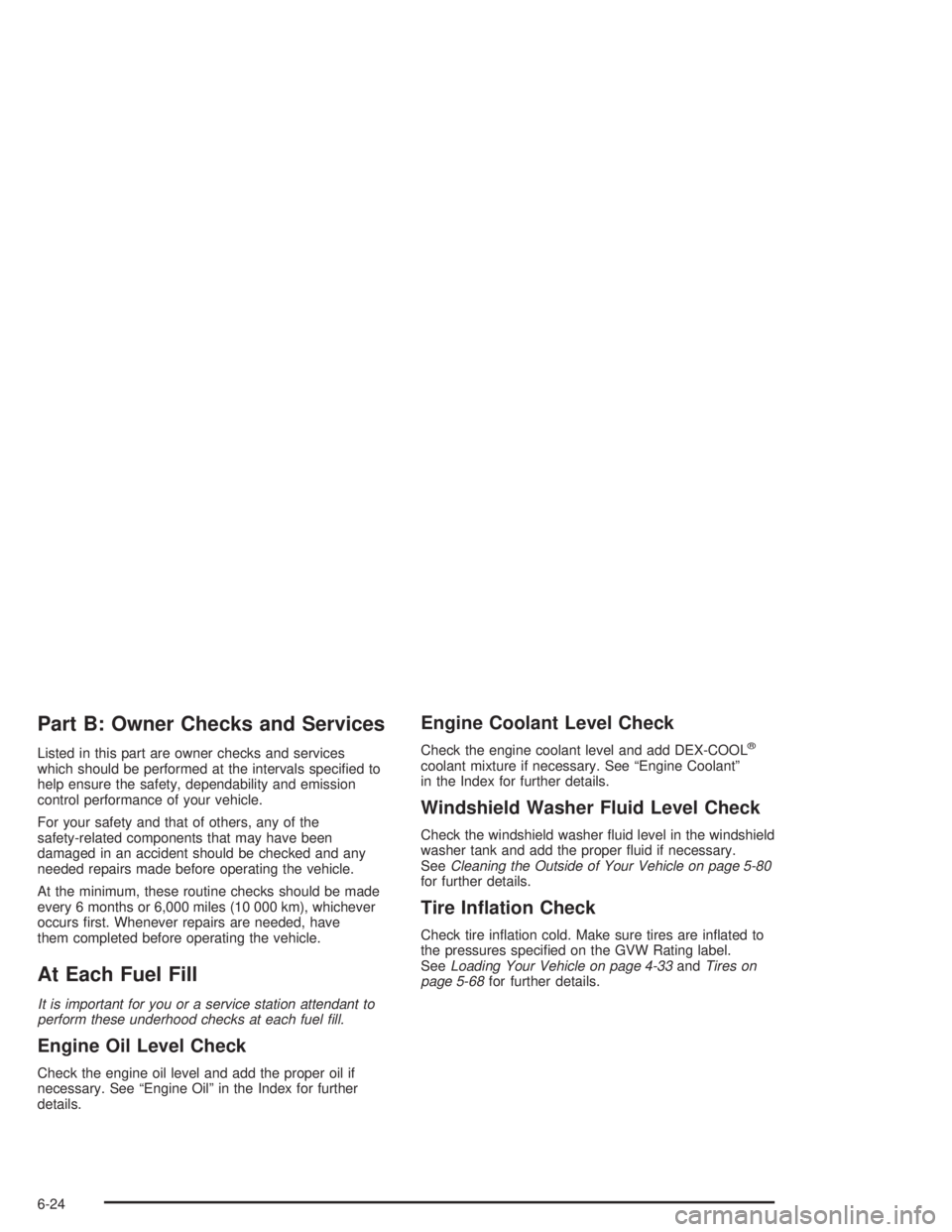
Part B: Owner Checks and Services
Listed in this part are owner checks and services
which should be performed at the intervals specified to
help ensure the safety, dependability and emission
control performance of your vehicle.
For your safety and that of others, any of the
safety-related components that may have been
damaged in an accident should be checked and any
needed repairs made before operating the vehicle.
At the minimum, these routine checks should be made
every 6 months or 6,000 miles (10 000 km), whichever
occurs first. Whenever repairs are needed, have
them completed before operating the vehicle.
At Each Fuel Fill
It is important for you or a service station attendant to
perform these underhood checks at each fuel �ll.
Engine Oil Level Check
Check the engine oil level and add the proper oil if
necessary. See “Engine Oil” in the Index for further
details.
Engine Coolant Level Check
Check the engine coolant level and add DEX-COOL®
coolant mixture if necessary. See “Engine Coolant”
in the Index for further details.
Windshield Washer Fluid Level Check
Check the windshield washer fluid level in the windshield
washer tank and add the proper fluid if necessary.
SeeCleaning the Outside of Your Vehicle on page 5-80
for further details.
Tire In�ation Check
Check tire inflation cold. Make sure tires are inflated to
the pressures specified on the GVW Rating label.
SeeLoading Your Vehicle on page 4-33andTires on
page 5-68for further details.
6-24
Page 336 of 366

Starter Switch Check
{CAUTION:
When you are doing this inspection, the
vehicle could move suddenly. If the vehicle
moves, you or others could be injured.
1. Before you start, be sure you have enough room
around the vehicle.
2. Firmly apply both the parking brake and the regular
brakes. See “Parking Brake” if necessary.
Do not use the accelerator pedal, and be ready to
turn off the engine immediately if it starts.
3. On automatic transmission vehicles, try to start the
engine in each gear. The starter should work only
in PARK (P), if equipped, or NEUTRAL (N). If
the starter works in any other position, your vehicle
needs service.
Automatic Transmission Shift Indicator
Check
Check that the indicator points to the gear chosen.
Steering Check
Be alert for any changes in steering action, abnormal
front tire wear or steering wheel position. An inspection
or service is needed when the steering wheel is
harder to turn or has too much free play, or if there are
strange sounds when turning or parking.
Brake System Check
Be alert to illumination of the low air warning lamp or for
the tone alarm, or changes in braking action, such as
repeated pulling to one side, unusual sounds when
braking or increased brake pedal travel. Make sure air
brake system reservoirs are drained daily with full
system air pressure, and check system for leaks. Any of
these conditions could indicate the need for brake
system inspection and/or service.
Engine Cooling System Service
Inspect the hoses and have them replaced if they are
cracked, swollen or deteriorated. Inspect all pipes,
fittings and clamps; replace as needed. Clean the
outside of the radiator and air conditioning condenser.
To help ensure proper operation, a pressure test of
the cooling system and pressure cap is recommended
at least once a year.
6-26
Page 337 of 366
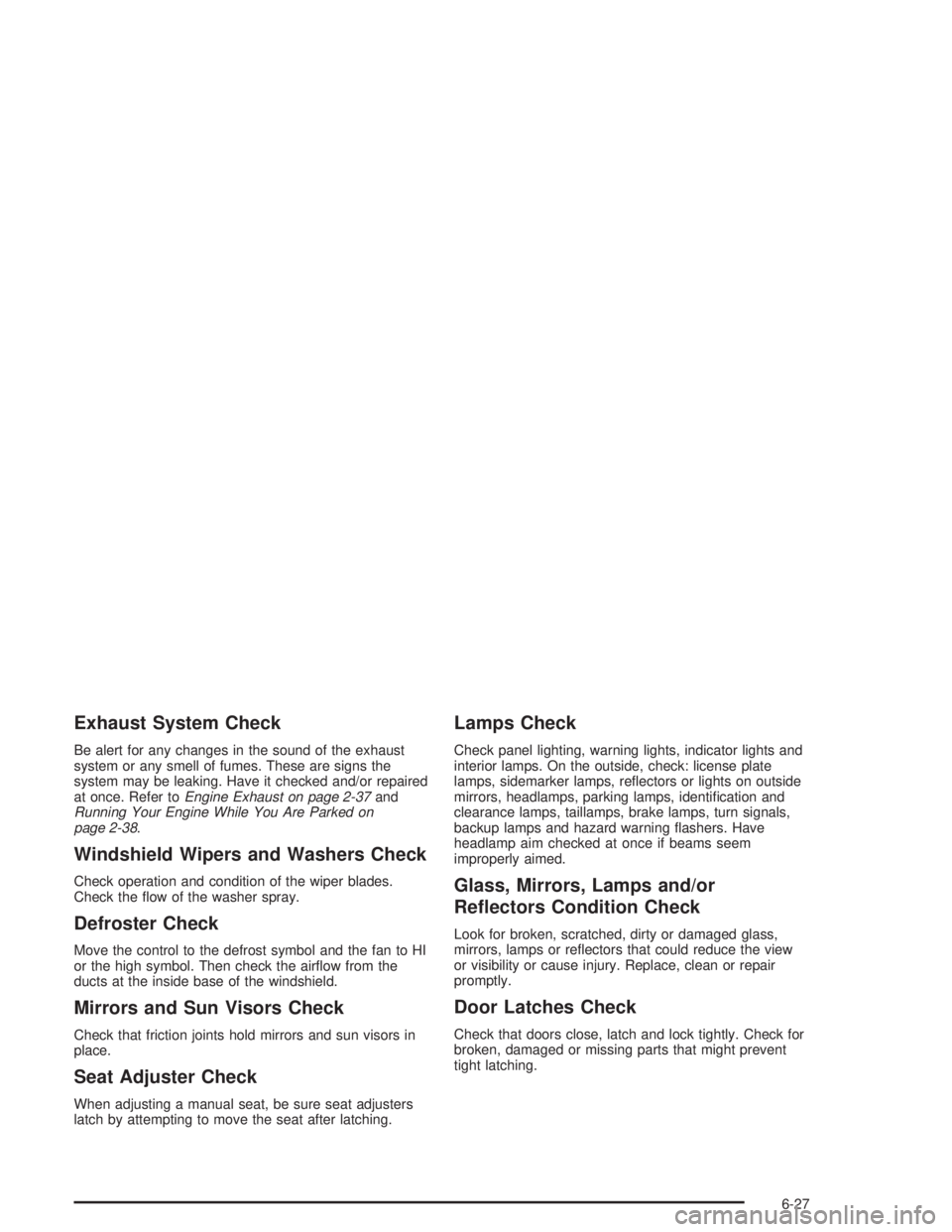
Exhaust System Check
Be alert for any changes in the sound of the exhaust
system or any smell of fumes. These are signs the
system may be leaking. Have it checked and/or repaired
at once. Refer toEngine Exhaust on page 2-37and
Running Your Engine While You Are Parked on
page 2-38.
Windshield Wipers and Washers Check
Check operation and condition of the wiper blades.
Check the flow of the washer spray.
Defroster Check
Move the control to the defrost symbol and the fan to HI
or the high symbol. Then check the airflow from the
ducts at the inside base of the windshield.
Mirrors and Sun Visors Check
Check that friction joints hold mirrors and sun visors in
place.
Seat Adjuster Check
When adjusting a manual seat, be sure seat adjusters
latch by attempting to move the seat after latching.
Lamps Check
Check panel lighting, warning lights, indicator lights and
interior lamps. On the outside, check: license plate
lamps, sidemarker lamps, reflectors or lights on outside
mirrors, headlamps, parking lamps, identification and
clearance lamps, taillamps, brake lamps, turn signals,
backup lamps and hazard warning flashers. Have
headlamp aim checked at once if beams seem
improperly aimed.
Glass, Mirrors, Lamps and/or
Re�ectors Condition Check
Look for broken, scratched, dirty or damaged glass,
mirrors, lamps or reflectors that could reduce the view
or visibility or cause injury. Replace, clean or repair
promptly.
Door Latches Check
Check that doors close, latch and lock tightly. Check for
broken, damaged or missing parts that might prevent
tight latching.
6-27
Page 338 of 366

Hood Latches Check
Check that the hood closes firmly. Check for broken,
damaged, loose or missing parts that might prevent tight
latching. Make sure the secondary latch (if equipped)
keeps the hood from opening all the way when the
primary latch is released.
Fluid Leaks Check
Check for fuel, coolant, oil or other fluid leaks by looking
at the surface beneath the vehicle after it has been
parked for awhile.
Underbody Inspection
Corrosive materials used for ice, snow removal and dust
control can collect on the underbody. If these materials
are not removed, accelerated corrosion (rust) can
occur on underbody parts such as fuel lines, frame, floor
pan and exhaust system. At least every spring, flush
these materials from the underbody with plain
water. Take care to clean well any areas where mud
and other debris can collect. Sediment packed in closed
areas of the frame should be loosened before being
flushed.
Engine Cover Check
Check that the cab’s engine cover and seal (if equipped)
are not torn or damaged. Be sure that the cover is
clamped down firmly to the floor.
At Least Once a Year
Key Lock Cylinders Service
Lubricate the key lock cylinders with the lubricant
specified in Part C.
Underbody Flushing Service
At least every spring, use plain water to flush any
corrosive materials from the underbody. Take care to
clean thoroughly any areas where mud and other debris
can collect.
Tractor Protection (Breakaway) Valve
Check
On air brake models, remove, disassemble, clean and
inspect the tractor protection (breakaway) valve.
6-28
Page 352 of 366
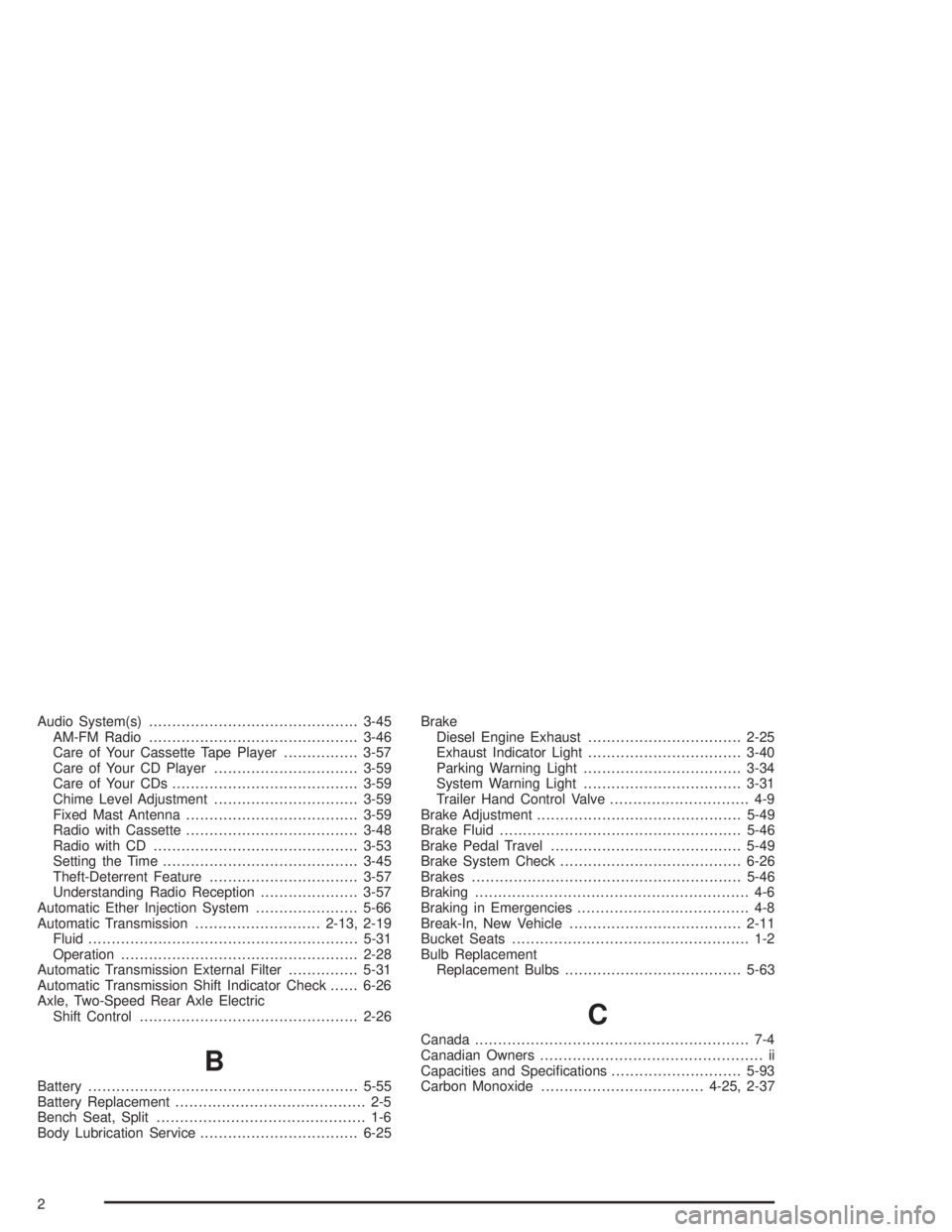
Audio System(s).............................................3-45
AM-FM Radio.............................................3-46
Care of Your Cassette Tape Player................3-57
Care of Your CD Player...............................3-59
Care of Your CDs........................................3-59
Chime Level Adjustment...............................3-59
Fixed Mast Antenna.....................................3-59
Radio with Cassette.....................................3-48
Radio with CD............................................3-53
Setting the Time..........................................3-45
Theft-Deterrent Feature................................3-57
Understanding Radio Reception.....................3-57
Automatic Ether Injection System......................5-66
Automatic Transmission...........................2-13, 2-19
Fluid..........................................................5-31
Operation...................................................2-28
Automatic Transmission External Filter...............5-31
Automatic Transmission Shift Indicator Check......6-26
Axle, Two-Speed Rear Axle Electric
Shift Control...............................................2-26
B
Battery..........................................................5-55
Battery Replacement......................................... 2-5
Bench Seat, Split............................................. 1-6
Body Lubrication Service..................................6-25Brake
Diesel Engine Exhaust.................................2-25
Exhaust Indicator Light.................................3-40
Parking Warning Light..................................3-34
System Warning Light..................................3-31
Trailer Hand Control Valve.............................. 4-9
Brake Adjustment............................................5-49
Brake Fluid....................................................5-46
Brake Pedal Travel.........................................5-49
Brake System Check.......................................6-26
Brakes..........................................................5-46
Braking........................................................... 4-6
Braking in Emergencies..................................... 4-8
Break-In, New Vehicle.....................................2-11
Bucket Seats................................................... 1-2
Bulb Replacement
Replacement Bulbs......................................5-63
C
Canada........................................................... 7-4
Canadian Owners................................................ ii
Capacities and Specifications............................5-93
Carbon Monoxide...................................4-25, 2-37
2